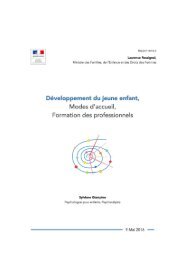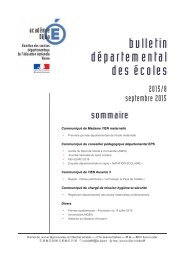agrl_innovations_in_ssa.pdf?utm_content=buffercb41d&utm_medium=social&utm_source=twitter
agrl_innovations_in_ssa.pdf?utm_content=buffercb41d&utm_medium=social&utm_source=twitter
agrl_innovations_in_ssa.pdf?utm_content=buffercb41d&utm_medium=social&utm_source=twitter
You also want an ePaper? Increase the reach of your titles
YUMPU automatically turns print PDFs into web optimized ePapers that Google loves.
commitments. The high price of <strong>in</strong>puts and low market prices are still of concern. Hence,<br />
IP focus is shift<strong>in</strong>g to produc<strong>in</strong>g crops for which there are ready markets<br />
IP activities are prov<strong>in</strong>g to be a useful model for the implementation of ASWAp at<br />
district level while simultaneously IP activities are mak<strong>in</strong>g an important contribution to<br />
the District Councils’ development plans <strong>in</strong> which food security, <strong>in</strong>come diversification<br />
and improved NRM are high priorities.<br />
Initial context. Malawi, with a population close to 13 million people, has a life expectancy<br />
at birth of 38 years with an estimated 29 percent of the population be<strong>in</strong>g undernourished<br />
and a high <strong>in</strong>cidence of stunt<strong>in</strong>g <strong>in</strong> children (FAOSTAT, 2011) unreliable ra<strong>in</strong>fall and decl<strong>in</strong><strong>in</strong>g<br />
soil fertility result<strong>in</strong>g <strong>in</strong> low and decl<strong>in</strong><strong>in</strong>g productivity. At the same time ris<strong>in</strong>g population has<br />
resulted <strong>in</strong> decreas<strong>in</strong>g farm size with fields cropped cont<strong>in</strong>uously. Most farmers are reliant<br />
on ra<strong>in</strong>fed agriculture with maize the overwhelm<strong>in</strong>gly dom<strong>in</strong>ant crop, although many farmers<br />
also grow a cash crop. Recognis<strong>in</strong>g the critical importance of agriculture as the cornerstone<br />
of susta<strong>in</strong>ed growth and poverty reduction, the Malawi Government was one of the first<br />
African countries to design and implement an ASWAp that was undertaken through a CAADP<br />
compact agreement. The ASWAp provided for decentralisation of priority sett<strong>in</strong>g, plann<strong>in</strong>g and<br />
implementation to <strong>in</strong>dividual District Councils.<br />
Challenges. Until recently farmers had limited access to improved seed and fertiliser and market<strong>in</strong>g<br />
surpluses was a problem. Challenges <strong>in</strong>cluded: improv<strong>in</strong>g access to quality seed, build<strong>in</strong>g the<br />
capacity of farmers to produce as a bus<strong>in</strong>ess opportunity and l<strong>in</strong>k<strong>in</strong>g farmers with markets<br />
Innovation triggers. As part of its national programme, Government, through its Farm Input<br />
Subsidy Programme, has assisted targeted households with subsidised <strong>in</strong>puts to boost food<br />
security. To support this programme FARA’s SSA CP ZMM PLS <strong>in</strong>itiated activities <strong>in</strong> ways<br />
consistent with the aims of Malawi’s ASWAp; establish<strong>in</strong>g three IPs <strong>in</strong> southern Malawi, one<br />
<strong>in</strong> Balaka District and two <strong>in</strong> Zomba District. Each IP acted <strong>in</strong> support of the respective District<br />
Councils’ own priorities for development <strong>in</strong> their respective areas. These form part of FARA’s<br />
SSA CP PLS <strong>in</strong> southern Africa, which <strong>in</strong>cludes n<strong>in</strong>e IPs, three <strong>in</strong> Malawi, three <strong>in</strong> Mozambique<br />
and three <strong>in</strong> Zimbabwe. This case study concerns the three <strong>in</strong> Malawi. Overall coord<strong>in</strong>ation<br />
across has been provided by CIAT for CA, CIMMYT for <strong>in</strong>tegrated soil fertility management and<br />
Bioversity International for vegetable production.<br />
Stakeholder <strong>in</strong>teractions and <strong>in</strong>terventions. Each IP brought together a range of stakeholders<br />
<strong>in</strong>clud<strong>in</strong>g farmers, researchers, District Government and NGOs, traditional leaders, local<br />
policymakers as well as the private sector <strong>in</strong>volved <strong>in</strong> <strong>in</strong>put supplies and output market<strong>in</strong>g.<br />
Each IP operated at both district and community levels, establish<strong>in</strong>g learn<strong>in</strong>g sites <strong>in</strong> five<br />
communities with<strong>in</strong> their respective areas focus<strong>in</strong>g on:<br />
• Improv<strong>in</strong>g crop yields us<strong>in</strong>g CA techniques <strong>in</strong> Balaka with coord<strong>in</strong>ation provided by CIAT<br />
• Improv<strong>in</strong>g maize and legume yields by us<strong>in</strong>g improved seed and fertiliser and <strong>in</strong>troduc<strong>in</strong>g<br />
legumes <strong>in</strong> rotation with maize <strong>in</strong> Zomba with coord<strong>in</strong>ation provided by the University of<br />
Malawi’s Bunda College (Kabuli and Kazombo, 2009 and Kabambe et al., 2010)<br />
The case studies: Southern Africa 57






